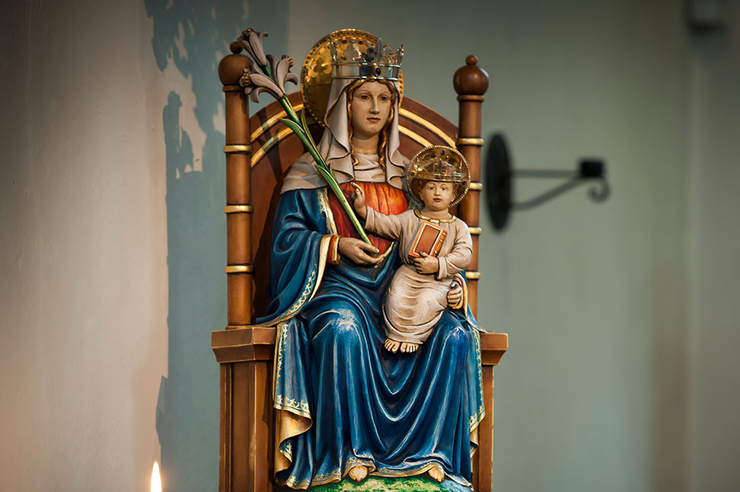Mary’s a Blankie Person: Our Lady of Walsingham
by Sarah Reinhard | September 28, 2015 12:04 am
 [1]
[1]Statue of Our Lady of Walsingham at the National Shrine (Catholic) in the U.K.
http://www.walsingham.org.uk/statue-of-our-lady-of-walsingham[2]
It was over ten years ago that I was reminded of the blankie of my youth, the one that had to be pried from my hands and that still remains in my memory as a cherished item. My mother, an avid sewer and enthusiastic grandma-to-be, had made and shipped approximately thirty-five million blankets for her new granddaughter.
Nearly three years later, when our second infant was born, my husband observed that the newest shipment of blankies (because each child needs their own stash, of course) had seemed to fan the fire of my own blankie love to greater heights. Did he catch me “fuzzing” them? Had he seen me rubbing my cheek against them? Was being a Blankie Person a bad thing?
Did Jesus have a blankie?
All this blankie love in my life made me wonder if the child Jesus had a blankie. Maybe, for Him, it wasn’t a blankie as I think of it. Maybe it was just a scrap of cloth.
Imagining Jesus with a blankie gives me a common ground with Him that I often lack. It makes Him more of a human, and more accessible. It also makes Mary, His mother, less intimidating.
Thinking of Mary as the Mother of God often throws me off in my reflections. After all, what do I have in common with someone who was holy enough to be the Mother of God?
When I imagine her, instead, as the mother of a boy who had a blankie, it helps me focus on the example she gives me, woman to woman, mother to mother, person to person.
Many of us struggle, and continue to struggle, with devotion to Mary, and, sometimes as a result, with devotion to her Son. Maybe that’s why she has appeared under so many different titles, in so many locations, clothed in so many various ways.
The English widow’s chapel
In the village of Walsingham, in Norfolk, England, in 1061, Mary appeared to a widow, Lady Richeldis, who later made sure that a chapel was built, a holy house built that was a replica of the house the Holy Family lived in during their time in Nazareth. For hundreds of years, pilgrims and devotees traveled there to pay their respects.
Then, in 1538, Henry VIII demanded that everything Catholic in England be destroyed, establishing a new church in which he was the equivalent of the Pope. The king’s soldiers destroyed the shrine and anything that would encourage continued devotion. They burned everything that couldn’t be taken with them and sold.
The revival of an old love
Walsingham parish priest Father Hope Patten discovered a medieval seal of the old monastery during a visit to the British Museum in 1912 and was inspired to have a statue built, which was placed in his parish church, St. Mary the Virgin, in Walsingham.
In no time, the pilgrims returned to venerate of Mary as Our Lady of Walsingham. In 1931, a new shrine was built because of the growing popularity of the devotion, with the holy house at its center and the image from the seal above the altar. A few years later, in 1938, the shrine was expanded to build the Anglican Shrine of Our Lady of Walsingham.
Mary, the blankie
Mary, as Our Lady of Walsingham, is a bridge, a common ground, a shared blankie of sorts, between the divisions created when the Church of England was formed. Through devotion to Our Lady of Walsingham, Anglicans and Roman Catholics have been inspired to stand side-by-side in prayer, to erect shared shrines, and to remember their common background and love of Mary.
How much of a stretch is it, really, to imagine Mary as a blankie? How often do we reach, blindly, for comfort in familiar places? Why wouldn’t our heavenly mother want to keep us just as warm and consoled as our favorite blankie?
Maybe Jesus didn’t need a blankie after all, when He had the arms of His mother. He could rest in the comfort of her care, just as we can. The image of her, our maternal blankie, can remind us of Mary’s protection and that of the angels who watch over us. The lesson, for me, is that Mary is the only blankie I need, the comfort that will always lead me back to the One I’m called to serve.
- [Image]: http://www.integratedcatholiclife.org/wp-content/uploads/the-statue-of-our-lady-of-walsingham-featured-w740x492.jpg
- http://www.walsingham.org.uk/statue-of-our-lady-of-walsingham: http://www.walsingham.org.uk/statue-of-our-lady-of-walsingham
Source URL: https://integratedcatholiclife.org/2015/09/reinhard-marys-a-blankie-person-our-lady-of-walsingham/